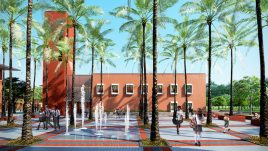Building a network: The Aga Khan Academy Maputo
“The network concept that I have mentioned is something that makes our academy endeavor a unique and distinctive one. And if there is one central thought I would like to have you take away from this day, it is the interconnected, international dimension of our envisioned academy experience.” – His Highness the Aga Khan, Hyderabad, India (20 September 2013)
During the inauguration ceremony of the Aga Khan Academy Hyderabad, His Highness the Aga Khan talked about his plans for the network of Academies that are being situated in 18 locations across 14 countries to educate talented students, regardless of their socio-economic, cultural or religious background. Following the first two Academies that are operating in Hyderabad, India and Mombasa, Kenya, the Aga Khan Academy Maputo in Mozambique is the third Academy in this growing network.
Each Aga Khan Academy is purpose built, and designed by renowned international architects. The Academy in Maputo opened in August 2013, initially for lower primary students, and has been growing steadily since then. The students have been housed at the Nursery campus, which was the first section to be built, while the next phase of campus construction took shape. On 17 January 2018, the Academy marked a significant milestone by opening the facilities intended for the Junior School campus. The new facilities include 12 classrooms, a library, outdoor play and recreation areas, as well as spaces for admissions, reception, offices and a staff room.
“The impact is stunning. We have had people stopping by who have seen the awning out front or heard we are building a school…There is a lot of interest from the community,” shares Chris Green, recently the interim Head of Academy in Maputo. Each Academy operates as an integral part of the surrounding community, and staff in Maputo have played an active role in sharing the Academy’s vision of developing home-grown ethical leaders with members of the local community. This has included, for example, organising open houses for current and prospective parents and reaching out to local businesses through information sessions.
The main beneficiaries of the construction – the students – have been eagerly watching the structures come to life and are thrilled with their school’s new facilities. “I like the school because it inspires children to have great ideas,” shares one student. “It’s really creative…it’s a really great school!” exclaims another student, with one of the younger ones saying, “I think the new school is nice and it has lots of space to play…It is really fun in the new school.”
AKA Maputo’s new Head of Academy, Michael Spencer, echoes the enthusiasm of the students. “It was wonderful to see the excitement and joy generated by the opening of the new building. The learning spaces are bathed in light, and the new library and technology areas have already become the focal point for student and community gatherings.”
An interconnected network
During the construction, the site also provided a platform for enhancing student learning and making curricular connections. Students followed the process of the construction and were given a tour of the site to further their exploration of the idea of settlement and how buildings and homes are influenced by factors such as climate, landscape and location.
Connecting the campus architecture to student learning is integral to the design of each Academy in the network. “The design of our buildings has a pedagogical dimension that can be used to educate students about many things beyond architecture – that’s really important,” shares Moyez Alwani, the Academies property development Senior Design Manager. In his role, Moyez is tasked with managing and ensuring the highest quality of design integrity in all projects from start to finish. This includes ensuring that pedagogical dimensions are included in the design of the architecture; incorporating feedback from students, parents, teachers and staff from existing Academies into future campus designs; and creating a sense of interconnectedness within the network of Academies.
Moyez elaborates on this notion of interconnectedness: “We often ask ourselves, how will this network of campuses be designed to speak with each other both implicitly and explicitly? How will the campuses be unique but also share similarity? What are the characteristics within each campus that would enable students to understand the culture of the wider place and setting in which they are studying?”
To address these questions, Moyez and his team are guided by a set of core principles located within the Aga Khan Academies Master Facilities Program (MFP) which aims to provide the fundamental underpinning to every campus. This complex and live document relates to all aspects of design for each Aga Khan Academy. This includes guidance on site selection, the overall design approach for a campus, life cycle aspirations for buildings, important spatial relationships between functions and common elements amongst all Academies to name a few. While there is a focus on the connectedness of the network, it is equally important that each Academy integrates the cultural context in the design of buildings and landscape.
“All of our Academies should educate students about the context they are living in. Each campus consciously aims to remind students of important local traditions through design; in the use of modern interpretations on local craft, localised materiality, contextual style, use of landscape. The truly exciting moments for us emerge when we start to see more of the ‘Network’ emerging, and each campus develops as part of this in a hugely different location and under very different conditions,” reflects Moyez.
Design features of AKA Maputo
The Aga Khan Academy Maputo draws its inspiration locally in many ways, one of which is through the use of simple and bold building forms with vibrant and often earthy colors. Moyez explains: “The soil of Maputo has a very particular orange-red colour which you just don’t find in many other parts of the world. The colors we have selected are earthier than usual, and when the Maputo sun hits them, they really come to life and create a colourful, vibrant and dynamic campus.”
Another major contextual factor that has informed the design of the Maputo project is the climate, which can be extreme during the summer months. The design team worked with international climate-engineering firms, to further engineer all the buildings and ensure that they can be passively cooled (without the need for air conditioning) throughout the year to provide comfortable learning environments while reducing the carbon footprint of the Academy. “We have learnt that the greatest impact comes from simple measures such as orientating our classrooms so they maximise cross ventilation, ensuring that the roofs of the buildings have a precise overhang so the glazed parts of the façade stay in shade and remain cool, protecting windows from the sun with deep projected window surrounds, planting trees to help with shade, etc…We are constantly working to make our buildings more sustainable and reducing their energy footprints,” shares Moyez.
A key feature of the design of the Maputo campus is the Ceremonial Court of Palms. This will be the first space visitors will encounter when arriving, allowing them to orient themselves to the campus and major buildings including the Commons, the Academy building and the Senior School library. It will be a large and formal plaza, planted with Royal Palm trees on a formal planting grid and using prestigious local trees to mirror designs for future campuses in Africa and elsewhere. The court will also have a unique, very tall, 23-metre tower – it will be the tallest building on campus, symbolising the presence of the Academy and aimed to function as an observation deck for students to explore the stars.
The heart of the campus, around which the school will be organised, is called the moyo (Swahili word meaning ‘heart’). This will be an informal open space around which a number of different functions are arranged. “The moyo should really encourage informal interaction between people on campus who will hopefully bump into each other regularly in an atmosphere of familiarity and sanctuary designed to promote collaboration…and of course to kick a ball around together!” explains Moyez. Upon completion of the Maputo project, the moyo will be a major external space connecting the Nursery, Junior and Senior Schools.
Michael reflects on the impact of the Junior School’s innovative design: “Whilst good teaching and learning can happen anywhere, it is fantastic to see first-hand how a well designed learning environment can contribute to student learning outcomes. As we learn to use these new spaces, it will be exciting to see how faculty and students adapt their teaching and learning styles to maximise the benefits of this outstanding new facility.”
The Aga Khan Academy Maputo will now move into the next phases of construction, which will include the Senior School, the residential buildings, the Academy Commons and a multipurpose complex.
By Karina Hussein
publications






